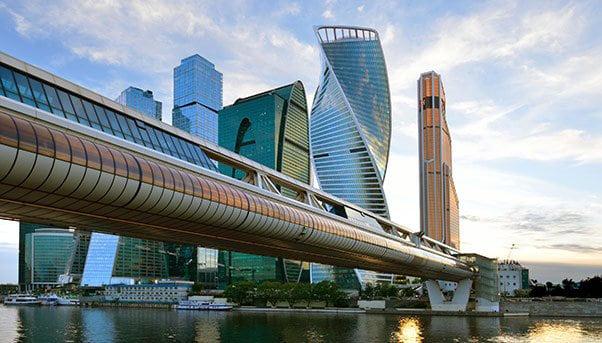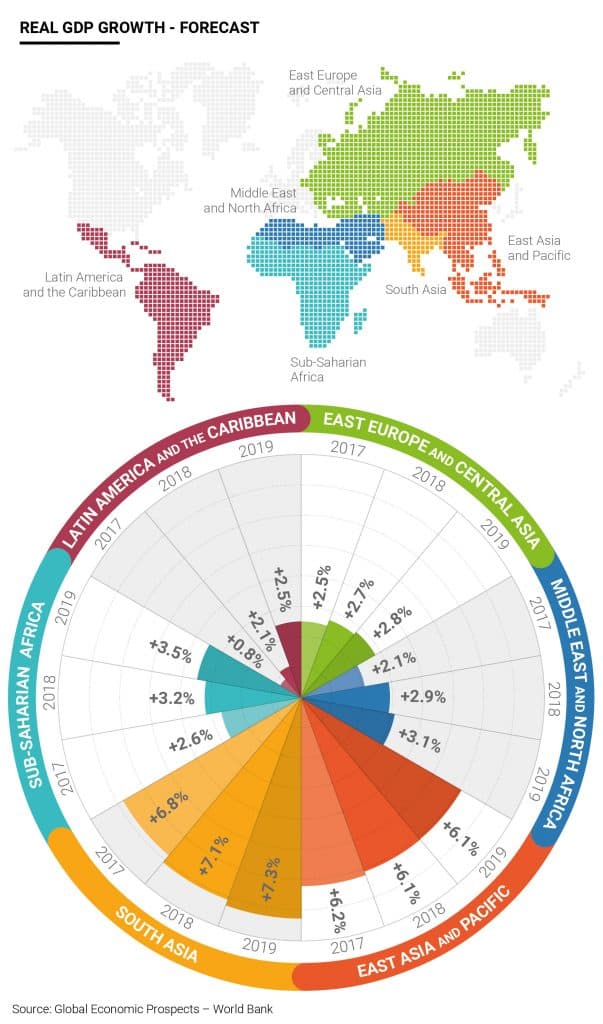
With their various reforms and ambitious investment programs, countries in the developing world like China and Ethiopia are charging ahead. Their economies are growing so fast that they are outstripping those in the developed world. Their rates are strong enough to have the World Bank forecast them surging twice as much as what economies like the United States, Japan or the euro zone promise to do. On average, developing countries are seen growing 4.1% this year, compared with 3% for the entire world. The United States, meanwhile, is forecast to reach 2.1%, Japan 1.5% and the euro zone 1.7%.
East Asia and the Pacific
Even though China’s economy, the region’s engine, has grown at a slower pace in recent years, it is still expected to reach 6.5% in 2017, giving a strong boost to neighbouring countries. The World Bank sees the region growing at 6.2% this year before slowing to 6.1% in 2018 and 2019. Excluding China, the average growth rates of the other countries in the region is seen at 5.1% this year before improving to an average 5.2% in the following two years. These gross domestic product (GDP) rates are due especially to exports from countries like Thailand and Indonesia at rates higher than 5%. These will result in an increase in public spending that could be directed towards infrastructure.
East Europe and Central Asia
Recovering trade in raw materials, positive global financial conditions and good growth in some countries within the eurozone are helping prop up the economies of East Europe and Central Asia. In 2017, they are seen hitting 2.5% before reaching an average 2.8% in 2018-2019. Encouraging signs are coming from Russia in particular, which is recovering lost ground after two years of recession with an expected growth rate of 1.3% in 2017. Turkey is seen up 3.5% despite the political uncertainties. The country is likely to surge forth in 2018-2019 at an annual 4%.
Latin America and the Caribbean
The region is suffering from a long period of economic stagnation because of the crises in Venezuela and Brazil. It is not expected to get out of the doldrums until 2018. This year its growth rate will be 0.8% but in 2018 it should go to 2.1% and 2.5% in 2019.
This performance is expected to come from the Caribbean in particular because the economies of this part of the region is showing signs of dynamism. The Caribbean is seen growing 3.3% this year to reach 3.8% in 2018 but easing to 3.7% in 2019.
The World Bank nevertheless talks of an irregular recovery due to Brazil and Argentina and their struggle to kick their economies into shape.
Once again, political instability is the region’s most pressing issue, and it is seen weighing on the economy. This instability comes in
part from the foreign policy of U.S. President Donald Trump’s administration as it seeks to renegotiate the North American Free-Trade Agreement (NAFTA). Mexico, more than any other, suffers from this predicament.

The Middle East and North Africa
Conflict and other geopolitical tensions as well as the low price of oil has obviously slowed the region’s economy. In 2017, the GDP is seen growing 2.1% more than one percentage point less than 3.2% in 2016. OPEC’s response to the low price of oil was a cut in production (a million barrels per day less in the first quarter), but this has not been enough to make the economy recover, especially in the Arab Peninsula where they have started to diversify their economies, like Saudi Arabia with its National Transformation Plan and Vision 2030 that foresee big investments in infrastructure. Some resilience is found in North Africa where political instability has not slowed economies down. Egypt is to grow 4.3% in 2017, Morocco 3.8%, Tunisia 2.3% and Algeria a more modest 1.8%.
South Asia
The region has one of the strongest collective economies. For 2017, its GDP is seen reaching 6.8% and an average 7.2% for 2018-2019. Its strength comes from India, boosted by a series of factors ranging from a rise in exports to low oil prices to increased investment in infrastructure. The country’s GDP is seen rising 7.2%. The region’s other heavyweight, Pakistan, will keep sustained rates of 5.2% in 2017 thanks to a rise in private investment and important reforms that provide more protection for workers and businesses. Generally, all of the countries in the region are dynamic economically, but they need to support their growth with rules and reforms. In Bangladesh,
whose growth is seen hitting 6.6%, a series of reforms has come into place to encourage competition in the private sector and attract direct foreign investment.
Sub-Saharan Africa
The strong performance by Ethiopia and a few other countries is helping pull the rest of the region along. After its GDP grew 1.3% in 2016, Sub-Saharan Africa is seen hitting 2.6% this year, 3.2% in 2018 and 3.5% in 2019. Ethiopia has the highest rate in the region, with its economy set to grow 8.3% in 2017, 8% in 2018 and 7.9% in 2019.
This is a result of a number of reforms adopted by the government and an ambitious investment programme to transform the country into a net exporter of electricity. Ethiopia recently inaugurated the Gibe III hydroelectric dam and is overseeing the construction of a bigger one called the Grand Ethiopian Renaissance Dam.
Commodities prices, to which many countries are exposed, are starting to rise, while the low price of oil is hitting Angola and Nigeria – two big exporters – hard.
Poverty is still a problem, however. The World Bank calculates pro-capita output will fall 0.1% in 2017 before rising 0.7% in 2018-2019.


